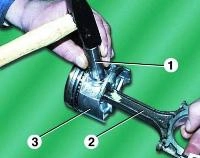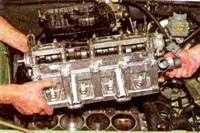In the article, we will consider the causes of engine failure and troubleshooting
Cause of malfunction - Remedy
Engine won't start
No fuel rail pressure:
- - clogged fuel lines;
- - the fuel pump is faulty; clogged fuel filter; faulty fuel pressure regulator
- flush and blow out the fuel tank and fuel lines; replace the pump; replace the filter;
- Check the regulator, replace the defective one
- Faulty ignition system
See "Features of the Niva Chevrolet engine management system"
Engine runs erratically or stalls at idle
- Insufficient fuel pressure in the engine fuel line ("ramp")
See "Engine won't start"
- Faulty idle speed controller
Replace the idle speed controller - article - "Idle speed controller Niva Chevrolet"
- Air leakage through the crankcase ventilation hoses and the hose connecting the intake manifold to the vacuum brake booster
Tighten the clamps, replace damaged hoses
- The gaps between the levers and camshaft cams are broken
Check hydraulic bearings, replace faulty ones
- Faulty ignition system
See "ESUD sensors Niva Chevrolet"
The engine does not develop full power and does not have sufficient throttle response
- Incomplete throttle opening
Adjust throttle actuators
- Faulty throttle position sensor
Replace sensor
- Insufficient fuel pressure in the engine fuel line ("ramp")
See "Engine won't start"
- Air filter dirty
Replace filter element
- Faulty ignition system
See "Engine management system"
- The gaps between the levers and camshaft cams are broken
Check hydraulic bearings, replace faulty ones
- Insufficient compression - below 1 MPa (10 kgf/cm2):
- cylinder head gasket broken;
- burning of pistons, breakage or occurrence of piston rings; poor fit of valves to seats;
- Excessive wear on cylinders and piston rings
Do the following: replace the gasket;
- clean the rings and grooves of the pistons from carbon deposits, replace the damaged rings and the piston; replace damaged valves, grind seats; replace pistons, bore and hone cylinders
Knock of crankshaft main bearings
Usually a dull, metallic sound.
Detected when the throttle is suddenly opened at idle. Its frequency increases with an increase in the frequency of rotation of the crankshaft.
Excessive axial clearance of the crankshaft causes a sharper knock with uneven intervals, especially noticeable with a smooth increase and decrease in the crankshaft speed
- Insufficient oil pressure
See "Insufficient idle oil pressure"
- Loose flywheel mounting bolts
Tighten the bolts to the recommended torque
- Increased clearance between journals and main bearing shells
Sand the necks and replace the liners
- Increased clearance between thrust washers and crankshaft
Replace thrust washers with new or increased thickness
Rattle of connecting rod bearings
Usually, the knock of the connecting rod bearings is sharper than the knock of the main bearings.
It is heard at idle speed of the engine with a sharp opening of the throttle. The place of knocking is easy to determine by turning off the spark plugs in turn
- Insufficient oil pressure
See "Insufficient idle oil pressure"
- Excessive clearance between the connecting rod journals of the crankshaft and the liners
Replace the liners and sand the necks
The sound of pistons
This knock is usually not sonorous, muffled; caused by the "beating" of the piston in the cylinder. It is best heard at low engine speeds and under load
-Increased clearance between pistons and cylinders
Replace pistons, bore and refinish cylinders
- Excessive clearance between piston rings and grooves on the piston
Replace rings or pistons with rings
Intake and exhaust valve noise
Working with increased valve clearances causes a characteristic knock, usually at regular intervals; its frequency is less than any other knock in the engine, since the valves are driven by a camshaft, the rotational speed of which is half the speed of the crankshaft
- Increased clearances between levers and cams control shaft
Check the hydraulic bearings, replace the faulty ones, article - Replacing the hydraulic compensators of the VAZ-2123 valves
- Broken valve spring
Replace the spring
- Excessive clearance between stem and valve guide
Replace worn parts
- Camshaft lobes wear
Replace camshaft and valve levers
Excessive camshaft drive circuit noise
From the general noise of the engine, the noise of the camshaft drive circuit stands out when there are gaps between the gearing elements and is clearly audible at a low crankshaft speed
- Weak chain due to wear
Replace the chain
- Breakage of the shoe of the chain tensioner or damper
Replace the tensioner shoe or damper, article - Niva Chevrolet damper replacement
- Defective chain tensioner
Replace the hydraulic tensioner, article - Replacing the Chevrolet Niva tensioner
Insufficient idle oil pressure on warm engine
- Foreign particles getting under the oil pressure reducing valve
Clean the valve from foreign particles and burrs, flush the oil pump
- Worn oil pump gears
Repair the oil pump
- Excessive clearance between the liners and the crankshaft main journals
Sand the necks and replace the liners
Excessive oil pressure on warm engine
- Oil pressure reducing valve sticking
Replace valve
Increased oil consumption
- Oil leakage through engine seals
Tighten fasteners or replace gaskets and seals
- Wear of piston rings and pistons or engine cylinders
Rebore cylinders and replace pistons and rings
- Broken piston rings
Replace rings
- Coking of oil scraper rings or slots in piston grooves
Clean the slots and rings from carbon deposits
- Wear or damage to valve stem seals
Replace oil seals
- Increased wear of valve stems or guide bushings
Replace valves, rebuild cylinder head
Increased fuel consumption
- Increased resistance to vehicle movement
Check and adjust tire pressure, brake system, wheel alignment
- Faulty ignition system
See "Engine management system"
- Faulty injectors
See "Checking and replacing injectors Niva Chevrolet"
- Fuel leakage in pipeline connections
Tighten pipe connections
- Use of low quality fuel
Fill with recommended fuel
Engine overheating
- Weak tension of the pump and generator drive belt
Adjust belt tension
- Insufficient amount of liquid in the cooling system
Add coolant to the cooling system
- The outer surface of the radiator is heavily soiled
Clean the outer surface of the radiator with a jet of water
- Faulty thermostat
Replace the thermostat, article - Replacing the thermostat VAZ-2123
- The radiator plug valve is faulty, the opening pressure is less than 0.05 MPa (0.5 kgf / cm2)
Replace cork
Faulty water pump
Check pump operation, replace or repair
Quick drop in the liquid level in the expansion tank
- Radiator damaged
Repair or replace the radiator
- Damage to hoses or gaskets in pipe connections
Replace damaged hoses or gaskets
- Liquid leakage from the heater tap
Replace the faucet
- Loose hose clamps
Tighten the clamps
- Liquid leakage through the coolant pump seal
Replace the oil seal
- Radiator cap or gasket damaged
Replace cork
- Damaged cylinder head gasket
Replace the gasket - article - Replacing the cylinder head gasket VAZ-2123
- Liquid leakage through microcracks in the block or in the cylinder head
Check the tightness of the block and cylinder head, if cracks are found, replace damaged parts
- Liquid leakage through microcracks in the body or cover of the coolant pump, expansion tank or inlet pipe
Check for tightness, if cracks are found, replace damaged parts; an insignificant leak can be eliminated by adding a sealant of the NIISS-1 type to the coolant











